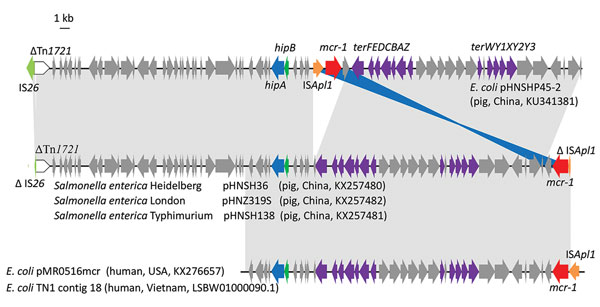Volume 23, Number 2—February 2017
Dispatch
mcr-1−Harboring Salmonella enterica Serovar Typhimurium Sequence Type 34 in Pigs, China
Figure 2

Figure 2. Genetic organization of scaffolds (portions of genome sequences reconstructed from end-sequenced whole-genome clones) containing mcr-1 harbored by plasmids pHNSH36, pHNZ319S, and pHNSH138 obtained during analysis of mcr-1–positive Salmonella isolates from pigs at slaughter, China, 2013–2014, and structural comparison with plasmids pHNSHP45–2, pMR0516mcr, and Escherichia coli TN1 contig 18. Arrows indicate positions and direction of transcription of genes. Regions with >99% homology are indicated in gray or blue. Triangles indicate truncated genes. Information in parentheses after isolates indicate source, location, and GenBank accession number.
1These authors contributed equally to this article.
Page created: January 17, 2017
Page updated: January 17, 2017
Page reviewed: January 17, 2017
The conclusions, findings, and opinions expressed by authors contributing to this journal do not necessarily reflect the official position of the U.S. Department of Health and Human Services, the Public Health Service, the Centers for Disease Control and Prevention, or the authors' affiliated institutions. Use of trade names is for identification only and does not imply endorsement by any of the groups named above.